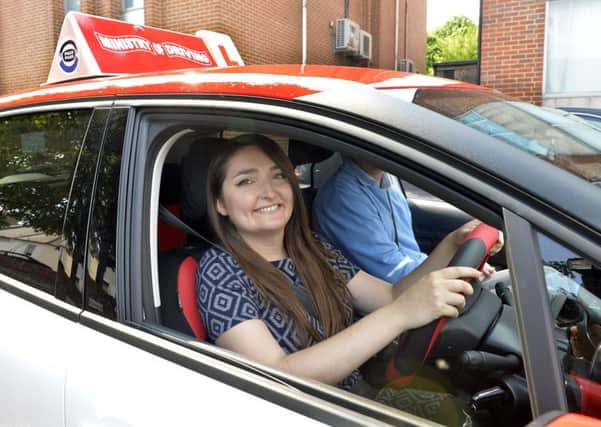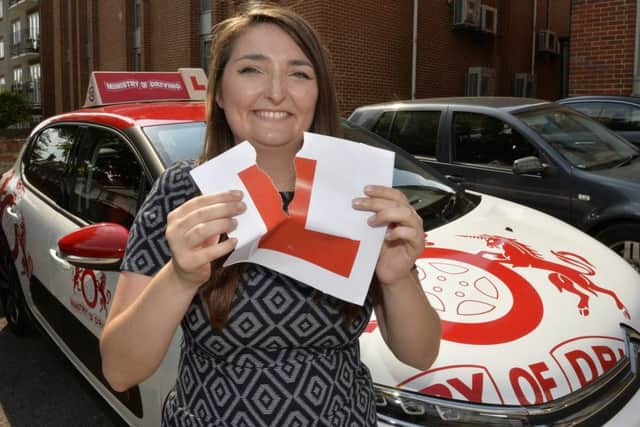Getting behind the wheel - what it's like to take your driving test


I execute a blood-curdling bay-reverse. The car edges backwards in pain-staking slow motion as it squeezes within the lines.
I switch the engine off and look over at the examiner, 100 per cent certain it’s going to be bad news.
Advertisement
Hide AdAdvertisement
Hide AdMy palms are sweaty. My seated heart is knocking at my ribs. Clang, clang, clang. Tears of pure stress start welling in my eyes.


“You’ve passed” he says.
The anticipatory tears burst out anyway. I cry. A lot.
Learning to drive is a very weird thing. It is the most unnatural thing in the world – sat in a metal box, your feet doing various things while your hands have to steer and change gears and your eyes are darting about looking in all the mirrors.
And all the while you have to abide by the laws of the road, vaguely know where you’re going, and negotiate other road users or pedestrians who may be acting like lemons. And you have to not crash.
I apologise to anyone who has encountered me on Eastbourne’s roads while I was clumsily figuring it all out.
Advertisement
Hide AdAdvertisement
Hide AdWeirder still is the test itself, it’s probably up there with the most intense situations known to man. You wait in a little room, anticipating a summons as sickly as to the executioner’s block. It’s utterly surreal.
But this is vastly overshadowed by the amazing feeling when you pass. I walked around grinning as though You Make My Dreams was playing, before remembering I am not Joseph Gordon Levitt in 500 Days of Summer.
It is an enormous confidence boost. It had been more than a year coming, and at times it felt like I just wouldn’t pass. That I was the exceptional person who it simply would not click with, and I almost resigned myself to the idea it was an impossibility.
Luckily, I was wrong. Learning to drive is a skill, one that comes much more easily to some. But the boring fact is: if you keep practising you can eventually crack it. Anyone, even me.
Advertisement
Hide AdAdvertisement
Hide AdI’m part of the ‘older’ generation of people who didn’t dive into a driving seat when the clock struck midnight the moment we turned 17. We’re the group of people who, for whatever reason, have put it off and off until we finally get sick of Southern Rail and relying on buses or cycling or, in desperate situations, taxis to get anywhere.
My driving instructor, Colin Goodsell of Ministry of Driving, explained why this might be.
He said, “We still get the 17-year-olds but the demographic is massively changing, people are learning much later in their lives, not just through personal experience but life itself, they are leaving university then learning to drive.
“I think the recent financial situation has had an impact on that but public transport has had an influence too, it’s easier to get across towns and people don’t need to learn to drive so much.
Advertisement
Hide AdAdvertisement
Hide Ad“But also there’s an expense part as well, insurance costs have increased. But with the right training, they can be brought down.”
When asked if he thinks driving is harder nowadays, he said, “Since I passed my test 30 years ago I don’t believe driving has got any harder but there are more cars on the roads.
“Layouts are changing all the time and whereas before you may never have seen a particular road feature but have hear about it, it’s now quite common. For example gyratory roundabouts like Cop Hall Farm.
“The test itself has changed massively in recent years, as well as when they first started.”
Advertisement
Hide AdAdvertisement
Hide AdJust this year the practical driving test removed a number of manoeuvres and added a Sat Nav part. And this summer, for the first time ever, learner drivers will be able to have lessons on a motorway – if they want to and their instructor thinks they’re ready, that is.
Discussing the new test, Colin said, “It’s taking into more practical driving and real life situations. Like removing corner reverse – very rarely do you need to use that, you are more likely to have to pull up on the right side of the road.
“I’m finding the Sat Nav a massive change, and it’s showing how pupils can be distracted by something else in the car and they have to work with to the mix of information coming from the road ahead of them and the Sat Nav itself.”
A roundabout expert, Colin has been teaching people how to drive for 14 years.
Advertisement
Hide AdAdvertisement
Hide AdHe said, “I enjoy not only the big success of someone passing but the small success an individual may have just conquering a fear or mastering a particular skill. I really enjoy that.”
As I prepare for my first solo drive as a legitimate road-user, I’m looking forward to the small successes of conquering my self doubt, bit by bit.
Visit www.driving-school-eastbourne.co.uk for more information.